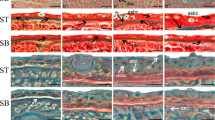Abstract
The granular glands of amphibian skin synthesize and store a large amount of bioactive amines and peptides which are structurally similar to mammalian brain-gut peptides. To investigate the development of peptide- and amine-producing cells in the granular glands, pieces of dorsal skin taken at various stages fromXenopus laevis tadpoles were cultured, and the contents of caerulein and 5-hydroxytryptamine (5-HT) were measured. When pieces of skin from tadpoles at stages 57 to 60 (Nieuwkoop and Faber stages) were cultured in a medium containing 10% fetal calf serum (FCS medium) or one containing FCS treated with charcoal (chFCS medium), the caerulein and 5-HT levels were increased for the six days of the incubation period. The caerulein content was lower in the chFCS medium than in the FCS medium. Addition of thyroxine to the chFCS medium had no significant effect on the caerulein content. These results show that the caerulein-and 5-HT-producing cells of the granular glands can develop in a culture system with FCS- or chFCS-containing media, and suggest that FCS contains substances which are absorbed by charcoal and stimulate development of the amine- and peptideproducing cells of the glands. In a preliminary search for correlation between caerulein and 5-HT synthesis, addition of 5-hydroxytryptophan (5-HTP), a precursor to 5-HT, to the FCS medium increased 5-HT content and, conversely, caused significant decrease in caerulein content, suggesting that accumulation of caerulein in the granular glands is influenced by the amount of 5-HT synthesis. These studies indicate that this culture system is a useful model for investigating the development of peptide- and amine-producing cells.
Similar content being viewed by others
References
Erspermer, V., Trends Neurosci.6 (1983) 200.
Vanable, W. J. Jr. Devl Biol.10 (1964) 331.
Seki, T., Kikuyama, S., and Yanaihara, N., Cell Tissue Res.258 (1989) 483.
Anastasi, A., Bertaccini, G., Cei, J. M., De Caro, G., and Erspamer, V., Br. J. Pharmac.38 (1970) 221.
Dokray, G. J., and Hopkins, C. R., J. Cell Biol.64 (1975) 724.
Araki, K., Tachibana, S., Uchiyama, T., Nakajima, T., and Yasuhara, T., Chem. Pharmac. Bull.21 (1973) 281.
King, J., and Millar, R. P., Gen. comp. Endocr.44 (1981) 20.
Zasloff, M., Proc. natl Acad. Sci. USA84 (1987) 5449.
Kollros, J., and Kaltenbach, J. C., Physiol. Zool.25 (1952) 163.
Bovbjert, A. M., J. Morph.113 (1963) 231.
Delfino, G., Brizzi, R., and Calloni, C., Z. mikrosk.-anat. Forsch.96 (1982) 948.
Delfino, G., Brizzi, R., and Calloni, C., Z. mikrosk.-anat. Forsch.99 (1985) 225.
Nieuwkoop, P. D., and Faber, J., Normal Table of Xenopus laevis (Daudin). North-Holland Publ. Co, Amsterdam 1956.
Iguchi, K., Yanaihara, C., Kubota, M., Iwanaga, T., Fujita, T., Matsuno, Y., Miyoshi, A., and Yanaihara, N., Biomed. Res. Suppl.4 (1983) 189.
Reilly, D. S., Tomassini, N., and Zasloff, M., Devl Biol.162 (1994) 123.
Ishizuya-Oka, A., and Shimozawa, A., In vitro cell. devl Biol27A (1991) 853.
Vanable, J. W. Jr., and Mortensen, R. D., Expl Cell Res.44 (1966) 436.
McGarry, M. P., and Vanable, J. W. Jr., Devl Biol.20 (1969) 426.
Wilson, S. P., Chang, K.-J., and Viveros, O. H., Proc. natl Acad. Sci. USA77 (1980) 4364.
Wilson, S. P., J. Neurochem.49 (1987) 1550.
Stachowiak, M. K., Hong, J. S., and Viveros, O. H., Brain Res.510 (1990) 277.
Kessler, J. A., Neuroscience15 (1985) 827.
Yoshie, S., Iwanaga, T., and Fujita, T., Cell Tissue Res.232 (1985) 25.
Leloup, J., and Buscaglia, M., C.r. Acad. Sci. Paris248 (1977) 2261.
Kawahara, A., Baker, B. S., and Tata, J. R., Development112 (1991) 933.
Author information
Authors and Affiliations
Rights and permissions
About this article
Cite this article
Seki, T., Kikuyama, S. & Yanaihara, N. In vitro development ofXenopus skin glands producing 5-hydroxytryptamine and caerulein. Experientia 51, 1040–1044 (1995). https://doi.org/10.1007/BF01946912
Received:
Revised:
Accepted:
Published:
Issue Date:
DOI: https://doi.org/10.1007/BF01946912




